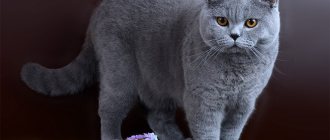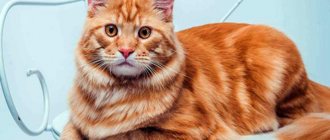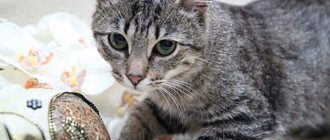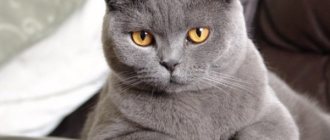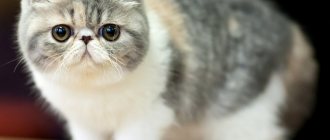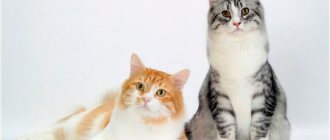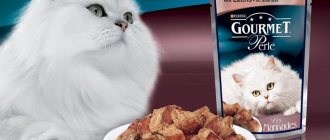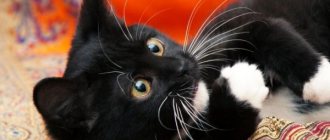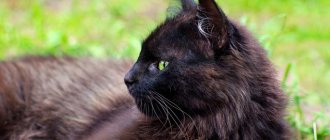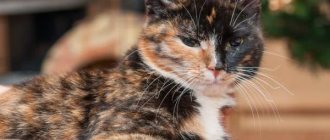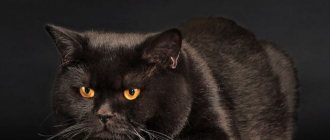Where does the British marbled cat come from?
Since the beginning of the 20th century.
British cats included not only plain blue animals, but also tabby cats with different shades on their fur coats. Thus, in 1901, American felinologists registered a Belle cat with a red tabby color. British marbled cats appeared as a result of crossing with other breeds
The consequence of two world wars was the almost complete extermination of the British breed, so breeders began to crossbreed pets with representatives of other varieties - Burmese, Russian Blues, Persians and Scottish. The result was the appearance of many varieties of British color while simultaneously preserving the breed characteristics (wide paws, protruding cheekbones, “plush” coat).
At the same time, among all the variations of the striped coat of the British fur coat, it is the marble color that is considered classic, occurring naturally. Zoologists are inclined to believe that the symmetrical darkening on the fur of catfish from Foggy Albion is an inheritance from wild Asian or African ancestors.
The history of the appearance of red British cats
Breeders were purposefully developing a bright red coat for the British. But since natural red color is never found in the British breed, genes from Persians and other exotics, in which this shade is not uncommon, were mixed in. It turned out to be quite difficult to obtain a pure sunny orange color, so selection work is still ongoing.
To breed the red color from the British, red Persians were mixed in with them.
BRITISH STRIPED COLOR (BRINCH, MACKERL)
The striped color of the British (British brindle tabby) must comply with all the same standards as the spotted one, only the pattern on the back and sides must have clear and uninterrupted stripes. In the color of a British Tabby Shorthair cat, the stripes should start at the spine and extend all the way to the paws. The stripes of a British brindle cat are narrow and frequent (and it is believed that the more often the better). Mackerel stripes (mackerel) should not intersect each other, be strictly vertical and always contrasting.
A brindle (striped) British kitten, even with very clear stripes, can “stretch” its color by adulthood and, if the stripes begin to be interrupted anywhere, the color is reviewed by experts and assigned - spotted. The full color of a British brindle kitten will be formed only by the age of one year (other tabby colors are not subject to such changes and most often do not change the appearance of the tabby pattern in adulthood).
British tabby cats are not as common as spotted cats, but more common than marbled cats.
The eye color of British tabby cats can be copper (golden, orange) or green (gold, occasionally silver).
Chocolate tabby British kitten: photo of California
Other colors
The above varieties are the most typical of the British Shorthair breed.
Nevertheless, we suggest considering several interesting varieties:
- cinnamon - the name comes from the English word “cinnamon” and accurately conveys the shade in which the British fur is dyed. Cinnamon kittens have a rich caramel color, and their special feature is pink pads and nose;
- Fawn is a shade that is monitored by the International Cat Federation. Faun looks like a lilac-silver cinnamon, lighter and more delicate;
- The smoky range acts as a separate type of wool, being divided into two subtypes - regular smoky and chinchilla. As for the first, it is characterized by high contrast: the undercoat is painted white, and throughout the body there is a pattern in the form of stripes, where the outer coat is colored in a darker color only at the tip. Chinchillas are distinguished by even greater lightening: in addition to the white undercoat, the main hair is colored silver or other light shades. If there are tabby cats, chinchilla varieties are called “whiskey” varieties - the coat can be marbled, striped or spotted;
- The British marbled cat belongs to the traditional, but rather rare, color types. The pattern of stripes creates a semblance of a pattern on marble. As has been noted more than once, marbled cats are found in almost all color variations;
- Britons with a tortoiseshell coat look bright and unusual - the whole body is covered with spots of several colors (usually a combination of chocolate and cinnamon, blue and cream, etc.). The tortoiseshell pattern does not appear immediately in kittens, and the final version of the pattern is acquired by individuals only by 12 months.
Types of drawings
Tabby is not one specific pattern, as many people believe. There are several varieties of it, and all are considered standard. The pattern appears due to the A gene (agutti). A British female with the color formula “AA” gives birth to only patterned kittens, and with “Aa” the ratio of patterned kittens to plain ones is 50%. Cats with the formula “aa” will be monochromatic.
There are four main types of tabby patterns: ticked, striped, marbled, spotted.
Ticked (Abyssinian)
At first glance, it may seem that the British ticked coat is a solid color, but this is not the case. The color of their coat is not at all uniform: the whole body has barely noticeable stripes, spots or specks (there are “freckles”), slightly darker than the main tone of the British. The tip of the tail is usually dark. Eyes are golden or green.
Striped, brindle (mackerel)
The British tabby cat is the most popular cat available. The second name appeared due to the similarity with the color of the mackerel fish. The pattern is characterized by frequent narrow, clear stripes throughout the body, especially along the ridge. British tabbys are characterized by necklace-like lines on the chest and a broken stripe on the forehead, reminiscent of the Russian letter “M”. The British cat's full brindle coloration develops by the age of one year.
Classic (marble)
One of the most favorite colors among breeders of this breed is the marbled tabby. It is visible already from the birth of the kitten, it may merge slightly, but by two months it has a clear pattern. The body is covered with wide ornate patterns with clear outlines on the back, sides and vague ones on the abdomen and paws. The color of the pattern contrasts with the main shade of the Briton’s body – a kind of marble on silver.
Spotted (leopard)
A cat of the British breed with this coloring is similar to a representative of the wild - a leopard, but in miniature. Wide stripes are intermittent and represent spots of various sizes. Eye color: copper, green.
Features of genetics and mating of red British dogs
Purely red British cats are rare mainly for the reason that to guarantee the appearance of a kitten of this color, both parents must have red (orange) fur, that is, they must have the corresponding gene in their gene set.
The color of cat fur is ensured by the presence of coloring pigments (melanins), which have different sizes and shapes; they may be present in the hairs in unequal quantities:
- phaeomelanin - oblong ellipsoidal grains that give the coat a color in orange, red and yellow;
- eumelanin - round spherical particles that color hair black because they absorb almost the entire spectrum.
There are only two main genes that determine a cat’s color: red and black.
Red color in relation to black is dominant and is designated by the letter “O”, black, respectively, is “o” (not red) . The gene that is responsible for the production of these substances is located on the X chromosome and is considered linked to the sex of the animal. The color of the future offspring is determined by both parents (cat and cat), who pass one chromosome to the kittens. Males have the XY set, that is, only one X chromosome. Therefore they can be:
- o - black;
- O - orange.
XX females have two such chromosomes and more color options:
- OO - red (red);
- oo - black;
- Oo and oO - black and red (turtle).
Cats are also sometimes tortoiseshell red and black, but this occurs as a result of a gene mutation (extra X chromosome). Such individuals are usually sterile (sterile).
Video: why only cats can be tortoiseshells, but not cats
The intensity of the red hue (lightness or dilution) is determined by the diluent gene D (Dilutor). If it is present, the animal has a light cream or yellow color (dilute red). At the same time, dye pigments are rarely located in the hairs, which gives such a pale, loose tonality.
Diluted red gives a creamy coat color
It has been noticed that the gene responsible for the red color of the coat is passed on from mother to son . When crossing a red British female with a black male, only half of the offspring will be red and these will only be cats. If you breed a red cat with a black cat, then there will be no orange offspring at all (only black and tortoiseshell ones). As a result of the mating of a male with red fur and a female tortoiseshell, half of the kittens (¼ females and ¼ males) will be red. Only 25% of ginger cats will produce a black cat and a tortoiseshell cat. Parents with red fur will have babies of the same shade (red or cream).
My office neighbor has a British tortoiseshell cat. She had already become a mother several times, and the kittens in the litter came in a variety of colors. Usually gray, blue and tortoiseshell. But one time, when they took some super certified black father as their father (they paid a lot of money for the mating), a completely unexpected offspring was born. That is, half were quite expected tortoiseshell, but the other two kittens were red. One is a bright orange, and the other is a pale, dirty yellow.
Kittens in the same litter can be different colors
Where did this color come from and why is it called that?
The question of where cats of such bizarre colors and different breeds come from will certainly arise if a British kitten appears in the house. The tabby color was most likely inherited by domestic cats from their wild ancestors, the Nubian Dun. It is from this species of cat that all our short-haired pets originated.
As for the term “tabby” itself, there are several versions about its origin. The most beautiful sounds like this. Somewhere at the beginning of the 17th century, silk fabrics, which were worth their weight in gold, were first brought to England. Their pattern was very similar to a cat's color and was called "tabbis". And when they later began to breed cats with a similar color, they were called tabby. In addition, cats of this color, like silk, were very expensive, since breeding them is extremely difficult - it is difficult to obtain the necessary pattern, shade and eye color that matches them.
PHOTO OF RED (RED) BRITISH KITTENS
The red British kittens in the photo in the gallery are presented below.
| In our cattery you can “buy a real British kitten.” We have many different colors, we will help you choose and answer all your questions! |
Health
The British Shorthair cat is not susceptible to hereditary diseases. She is in excellent health. However, this does not mean that vaccination and preventive examinations by a veterinarian can be neglected.
It must be taken into account that sexual and physical maturation in general occurs late in the British - around the age of four. It is at this age that kittens turn into adult cats: they show all the solidity and massiveness provided for by the standards. There is no point in sounding the alarm or suspecting dystrophy until this moment.
In comfortable conditions, a Briton lives on average 15 years. However, there are record holders in the breed whose age has exceeded 20. The reasons are simple: lack of stress, active cat life, balanced food and, of course, unconditional love. The well-being of the British largely depends on feeling like a member of the family.
Marbled Tabby
The marble tabby color in cats is the most beautiful, bright and complex. In addition, it is also the rarest due to difficulties in crossing - two marbled individuals can produce a tabby or spotted kitten. Such British cats wear three parallel stripes on the back, and large closed circles on the sides, inside of which there are brightly colored spots. Such a pattern should not intersect or be interrupted. In addition, a Marbled Briton must have the following markings:
- A pattern on the back of the head and shoulders resembling a butterfly.
- Patterns on the cheeks that start from the very corners of the eyes.
- "M" pattern on the forehead.
- The neck and chest are decorated with necklaces - the more, the better.
- There are spots on the tummy.
- The paws and tail must be ringed.
- The circles on the hips must be closed.
The color is rejected if the pattern is not contrasting enough, or if it shows residual faded stripes.
In a British cat, the merle color can be identified from birth. However, final alignment and clear drawing occur by two months. Therefore, if you want to get a real British harlequin, wait until this time, and do not adopt a kitten earlier.
Cat colors: what they are and how they are bred
Color, which is considered the most important characteristic of the breed, is the color of the animal’s coat and various patterns on the skin (spots, stripes, stains, etc.). In the wild, individuals of the same species have almost the same color. Cats, through the process of domestication and selection, have acquired a huge number of coat color options.
British cats can have different colors
A fairly small number of basic genes (solid color, diluents, lighteners, patterns, etc.) are responsible for this diversity, but when composed in different combinations they give an innumerable number of colors. New colors are developed taking into account the genes needed for selection, both dominant (suppressing) and recessive (suppressed), working with which, a competent breeder systematically achieves a new shade.
Required elements
The tabby color, despite many variations, has a number of unchanged elements:
- Ticking is actually the presence of the pattern itself. In this case, the hairs of the coat should be uniform in color down to the base.
- On the forehead of such cats there is always a pattern resembling the letter “M”, the so-called scarab sign.
- There should be a fingerprint-shaped spot on the back of the ear.
- The nose and eyes should be outlined. In this case, the color of the outline should be the same as the main color.
- The pattern, if there is one, must include the following elements: “necklace” - three closed stripes on the chest; “curls” on the cheeks; There are two rows of double spots on the tummy. All drawings should be clear and rich, and the coloring should be deep.
- There are also typical eye colors for tabbies - golden, orange and copper. If the color is silver, then the cat's eyes should be green.
If a Briton's color is blurred, and the patterns are cloudy and merge with the main color, then this is a defect. Most likely, one parent was a tabby and the other was a solid.
Standard colors
All cats - short-haired and long-haired - differ in the types of basic color, type of pattern and pigmentation. Blue is considered the traditional color, and it is also the most popular. However, other varieties are not at all signs of degeneration or deviation - the British are characterized by changes in the shade of their coat under the influence of various climatic or biological factors. Currently, experts have identified more than 200 shades of fur in British breed kittens. Based on the results of the research, tables are compiled that provide a complete classification of the colors of the British with the letter and code designation of the type of coat.
Black
The black color of British cats is considered quite rare and difficult to breed. The fact is that in a kitten that is born black, the color of the hair coat may change over time to chocolate
Therefore, breeders who dream of getting a black British dog are advised to pay special attention to the parents of the potential pet - the pigment of their coat should be as dark and rich as possible, and the color of the undercoat should not differ in gradation from the color of the main hair
Blue
The most famous type of British wool is blue. This type of color can vary in depth and darkness of shade. The most popular is the light gray look, in which the undercoat and main hair are of the same light tone. If the hair tone is darker, then the result is a traditional blue color. Cats of this variety can also be identified by their eyes: the irises of adult individuals are a beautiful amber color.
Lilac
Lilac varieties of British cats are characterized by a light coat color, the color of which consists of blue, silver and pink shades. Thanks to this unusual combination, the result is a color reminiscent of darkened white gold, and the purple tint gives the wool an elite look. Pigmentation in the case of lilac British cats is weak, the undercoat should be close to the color of the top coat. However, kittens may have a faint pattern that disappears with age.
Cream
Cream-colored cats have thick, beautiful fur that is soft and smooth to the touch. Cream-colored cats are produced by the presence of the lightening gene in red parents. The result is a kitten whose fur should be colored a delicate light beige shade. The outer hair can have a different tabby pattern - tiger stripes, marbled streaks or spots.
Chocolate
British chocolate-colored ones can have any shade - from light milky to rich dark. The cover of such cats is absolutely not inferior to representatives of other species, and the eyes of individuals of the chocolate range have an interesting color of bleached copper.
Red
The general color type, red, refers to Britons with red, gold or copper coats. Despite the excellent quality of the coat, the color range is uneven: often certain areas of the body can be lightened or ticked. Typically, the pads and tip of the tail of British Goldens are somewhat lighter than the base color, and there is a striped pattern on the forehead.
White
At the moment, white British cats are a very rare type, since at the end of the twentieth century the breeding of cats of this type was stopped. This is due to the fact that, in fact, the white color in animals is a manifestation of albinism, which always entails consequences for the health of both the individual carrier of the gene and its offspring. In true albino cats, the ticked areas should disappear by six months, leaving a perfectly white coat with no yellow spots.
Types of colors
Selection work on representatives of the British breed, involving various bloods, has led to a variety of both colors and breed types. If initially the British had short hair with a thick undercoat, then crossing with the Persian cat made it possible to obtain semi-long-haired animals. The colors of British longhair cats correspond to the colors of shorthair cats.
Many people only think of Britons as smoky, blue or tabby cats and don't even realize how many colors the breed has. Even a pair of quite ordinary parents can produce a kitten of a rare color.
To organize the variety of colors of British cats, they are divided into types and groups according to color, pattern and method of pigmentation.
Types of colors of British cats:
- solid (or plain);
- typed: smoky, veiled, shaded;
- gold;
- silver;
- tortoiseshells;
- color point;
- particolors: harlequin, bicolor, van, mitted;
- tabbies: spotted, striped, marbled, ticked.
A table of the colors of British cats will help you imagine all the diversity.
Briefly about the British
The British cat breed was first introduced in the second half of the 19th century, although images of animals visually very similar to the British can be found in manuscript books from the 7th and 8th centuries. Officially, breed standards were approved much later, in 1980. The breed is recognized by all world phenological organizations.
British cats were popular back in the 19th century
The British are characterized by a large, massive and muscular build. Males weigh on average about 6–8 kg, but some individuals reach 10 kg. Females are more graceful and smaller. The body is powerful, slightly squat, well molded, with a wide chest and massive shoulders, strong, slightly short legs.
A large round head with a wide skull, set on a strongly developed and short neck. The cheeks are convex and thick, the chin is strong and firm. Short ears with slightly rounded tips are set wide apart. Not too long, but quite proportionate, the tail thickened at the base, slightly tapering to a rounded tip.
All British cats have a massive, large build.
The British breed is famous for its short, plush and very thick coat with a high-quality dense undercoat. It is extremely pleasant to the touch, silky and tender.
Possible tabby colors
Among tabby cats, gray and silver cats predominate with markings of a wide variety of colors: lilac, chocolate, blue, smoky black, reddish. But this does not mean that other tabby colors are rare. In the table below we look at the main variations of tabby color.
Table 2. Possible flower combinations for tabby color
| Color name | Marking color | Leading coat shade |
| Amber | Smoke black | Peach |
| Black silver | Deep black | Silver |
| Blue | Gray dust | Ivory |
| Blue silver | Grey | White |
| Bronze | Dark chocolate | Warm cream |
| Brown | Black night | Gray with brown or copper fade |
| Cameo | Fiery red | Warm ivory |
| Caramel | Milk chocolate with light color | Beige |
| Coal | Black chocolate | Smoke gray |
| Chestnut | Bright brown | Cream with possible orange undertone |
| Chocolate silver | Milk chocolate | Light blue silver |
| Cinnamon | Light chocolate with red flecks | Several shades lighter than the drawing |
| Golden cinnamon | Cinnamon | Ivory |
| Cream | Bright cream | Pale cream |
| Cream silver | Cream | Delicate silver |
| Faun | Light beige with cinnamon | Pale beige |
| Gold | Black | Milk chocolate with light color |
| Delicate amber | Grey, light gray | Tender peach |
| Lilac | Gray with splashes of pink or blue | Light cream |
| Peach | Brown with pink | Delicate cream |
| Red | Fire orange | Several tones softer than the original pattern |
| Purple silver | Lilac | Light silver with lilac splashes |
| Silver | Deep black | White |
It is worth noting that colors may vary depending on the design. Thus, spotted patterns are often presented in warm colors: golden, chocolate, wheat, brown, reddish, red. The classic type combines contrasting patterns of dark stripes on a light background: cream, yellowish, gray. The basis for dark striped patterns is silver and gray. The ticked type offers almost all possible colors. You can read about the mechanisms of genetic inheritance of pigments from cat to cat below.
Pigments and options for their transmission
In addition, the pattern may vary depending on the breed.
Table 3. Tabby color options for different breeds
| Breed | Color name | Marking color | Primary coat color |
| California speckled | Bronze, coal, snow leopard, royal glitter | Bronze - chocolate, charcoal - dark chocolate, snow leopard - black, glitter - brown with black | Bronze, snow leopard - ivory, coal - dark gray, glitter - gold |
| Egyptian Mau | Mottled Bronze, Smoke Spots, Mottled Tin | Bronze – chocolate, haze – dark chocolate, tin – gray-black | Bronze - cream, haze - dark gray, tin - silver |
| Ocicat | Golden cinnamon, sienna, spotted tawny | Cinnamon – chocolate, sienna – beige, tawny – dark chocolate | Cinnamon, sienna - ivory, tawny - red |
| Australian smoke | Golden haze, peach | Haze - golden chestnut, peach - brown with a hint of pink | Haze is several shades lighter, peach is a light cream |
| Bengal cat | Leopard, snow | Leopard - red markings in black circles, snow - cream markings in black circles | Leopard – yellow cream, snow – white |
Tabby cats with a rarer color are valued higher - because of this, they can cost more than their counterparts.
British breed colors
In addition to all its numerous and undeniable advantages, the British cat breed is famous for its bright and generous palette of colors - almost their entire line is presented in the breed standard. Only the most popular and well-known colors among the British have up to six dozen! And if you count new, rare colors and variations, the total number will be up to two hundred.
Different colors may be present in one litter
But even this seemingly democratic approach to the variegated ribbon of colors is clearly regulated by the breed standard in each specific case. In the exhibition evaluation of an animal, there is a very large quota of expert evaluation specifically for color - according to the standards of various international felinological organizations, this ranges from 15 to 25 points.
British cats of all stripes - photo gallery
Blue color is popular and common among the British
Chocolate color has become increasingly popular lately.
Whiskas color gained wide popularity thanks to... television advertising
The fawn color is very rare, it is easy to confuse it with others
Marble color - it is also called “wild”
Black color in its pure form is of great value for the British
The white color of the British looks special
Cinnamon color is completely exotic!
Tortoiseshell color is very impressive, but is characteristic only of cats
Color point color - and this happens in British cats
Bicolor color has a huge variety of options
Tabby color is characterized by dark stripes and spots.
Red color: a red cat is always charismatic
The cream color gives the cat intelligence and thoroughness.
The golden color is not only by name, but also rightfully considered precious
The lilac color looks extremely elegant
Blue (gray)
The blue color can be called classic for the British cat breed. Against the background of plush gray fur, huge eyes of all shades of amber look especially impressive.
Blue British cat is a classic of the breed
The color spectrum is quite wide - from very light gray to a deep and dark shade of graphite. But the development of the breed is still moving towards lightening - breeders are trying to move away from darkened versions of the blue color in breeding.
Gray fur is soft, dense and matte; it cannot shine or shimmer with silver. Each hair must be evenly dyed along its entire length; the slightest inclusions and shades of other colors are considered defective and are categorically not welcome. Uniformly gray - and no other! - there may be both the nose and the pads on the paws of a blue British cat. For this color, the standard allows three eye colors:
- rich golden;
- copper;
- orange.
Some nuances of color in the form of unexpressed patterns and darkening can only be observed in small kittens - provided that with age all these unevennesses disappear without a trace. Children's fur can also change color, even significantly change its shade, mainly in the lighter direction.
Video: blue Briton named Harry
White
The white British cat looks stunning, but this color remains rare in the breed - breeders do not strive to “put it on stream”, since they are well aware of the difficulties associated with this.
The white British cat is a very beautiful but problematic animal
The main requirement for the color of white British dogs is brightness and purity of color. Even the slightest inclusions of other colors and shades are considered faults - the most common problem in this sense is untidy yellowish spots, which are most often localized on the face or at the root of the tail. white kittens are sometimes born with dark markings, but the spots in almost all cases disappear by the age of one year.
The nose and paw pads are unpigmented and pink; but for the eyes the standard allows a very expressive palette of options:
- blue;
- yellow;
- odd-eyed (blue and yellow).
Breeders know how difficult it is to get an animal of the standard white color - this is a rarity in the breed. Another problem for breeding is that it is impossible to breed two white animals - this creates a high risk of having offspring with hearing atrophy.
Video: lazy handsome white guy
Black
A British cat of the correct black color is extremely rare and valuable; Usually it is in this color that certain problems appear, which are assessed by experts as shortcomings or even as a defect.
The black British cat is a rarity in the breed
The structure of the British breed's black coat stands apart from many other colors - it is more rigid and shiny. It is very important that the tone of the undercoat completely matches the tone of the guard hair. Various kinds of color stretches and spots are not allowed - a black Briton should not have even a hint of smokiness or pattern. But the ideal, deep black color is only achieved by a few representatives of the breed - often with age it becomes somewhat blurred and becomes inexpressive.
With this color, both the nose and paw pads should be black, without any options. But for the eyes the usual breed colors are acceptable:
- golden-bright;
- orange;
- copper.
Experienced breeders try to carefully select breeding sires with deep black, shiny wool for mating - otherwise the offspring have a high risk of overcoloring and the appearance of “untidy” shades of black color - grayish and brown.
Video: perfect black cat
Cream
The delicate and charming cream color of British cats is also called peach or beige - these British cats look very elegant and are now at the peak of popularity.
Cream British are one of the most popular today.
The beige color of varying degrees of saturation should be evenly distributed over the animal’s body, and traces of the pattern on the fur should be practically invisible. It is important that each hair is dyed along its entire length without color transitions; inclusions of white hairs are not allowed.
In peachy Britons, both the nose and pads are soft pink, and the following options are acceptable for the eyes:
- rich golden;
- copper;
- orange.
Beige babies can only be born from a pair of cream British dogs, or if the parents are carriers of the genes for this color.
Video: cream cat, cheerful and beautiful
Chocolate
It is no coincidence that the Briton's color of all shades of chocolate - from milk to almost black - is at the peak of cat fashion: he looks spectacular at exhibitions and is quickly winning the sympathy of ordinary owners.
Chocolate British cat is a relatively new, but already popular color
This color, which is quite new for the breed, immediately turned out to be in demand, but there are still some difficulties in its formation - in an animal it is fully manifested only by one and a half years, and it is definitely impossible to predict from a small kitten what color its coat will acquire. A minimum of pattern on the coat, no white spots or even hairs - the standard requirements for this color are strict.
The nose and paw pads of a chocolate-colored animal should be evenly colored chestnut, and the eyes can have the following colors:
- bright yellow;
- dark orange;
- copper.
To fix the color, it is very important that the chocolate gene is present in both parents of the breeding pair - otherwise there may not be kittens with this color in the litter at all.
Video: playful chocolate kitten
Lilac
On the coat of the British, the lilac color looks sophisticated and unusual - such kittens are always in demand, which stimulates breeders to search for new, more expressive shades of color.
The lilac color of the British cat is characterized by unusual nuances of color
Today's standard lilac color allows for three main shades:
- light;
- average;
- dark.
The coat of such cats is short and truly “plush”; a subtle smokiness, manifested in a slightly lightened undercoat, is acceptable. Depending on the saturation of the main tone, the nuances of the beige color in which the nose and pads on the paws are painted can also change significantly. The eyes of a lilac Briton should be of the following colors:
- dark gold;
- copper;
- orange
Light shades of color are considered the most popular and promising - based on them, breeders achieve amazing color compositions, including pastel shades of pink and purple.
Video: young lilac cat
Red
The red British cat is one of the brightest, in the truest sense of the word, representatives of its breed. The red color itself is quite complex; there are important nuances that need to be taken into account.
The red British cat is a bright representative of its breed
The breed standard is relatively loyal to the red color of the British, but still makes certain, quite clear requirements for it. Ideally, uniform coloring of the coat is desirable; only minimal darkening and some hint of pattern are acceptable. The brighter, deeper and more saturated the red color is, the higher the value of a particular individual.
The “mirror” of the nose and the pads on the paws of a ginger British cat should have the color of terracotta. As for eye color, the standard provides the following options:
- red;
- orange;
- copper.
Unfortunately, the ideal red color in the British breed is still extremely rare, although breeders are actively working in this direction.
Video: red British furry
Tortoiseshell
The British “tortoise” is an amazing natural phenomenon; each of these cats is unique and unrepeatable. Tortoiseshell coloring occurs in a combination of dark and light colors, more or less evenly distributed throughout the animal's body.
Each British tortoiseshell is unique and inimitable
“Torti,” as this color is also called, has up to eighty different variations, which can be divided into several main subgroups:
- classic turtles;
- smoky turtles;
- tortoiseshell tabby (torby);
- tortoiseshell color-point (tortie);
- tortoiseshell bicolor (calico);
- tortoiseshell tabby with white (mixed color).
British tortillas are always elegant and charismatic. The breed standard is highly creative in relation to the tortoiseshell color - the most incredible and imaginative combinations of elements of various patterns, small spotting and patchiness are allowed. The main thing is that the cat looks harmonious and beautiful as a result. The fur of British breed turtles is short, densely packed, plush and soft. The eyes can be copper or dark gold, and there are different options for the nose and paw pads:
- pink;
- black;
- pink and black.
As with all other cat breeds, in the British tortoiseshell color can only be found in females or, in very rare cases, infertile cats.
The main thing is love and affection
Cats of this breed are very sensitive and vulnerable. They definitely need to be petted, otherwise they get offended and worried. Simply feeding is clearly not enough. You need to take her in your arms and say kind words. They feel everything. Sometimes, even too much.
However, these cats will never impose themselves and get in the way
The owner himself must take the initiative and show attention to the pet.
Tabbies are very friendly and trusting. This breed is an excellent choice for families with small children. Cats will patiently endure any treatment from their little owners and will never show even a shadow of aggression towards them, not to mention extending their claws.
Representatives of this breed get along well with other pets. They can make excellent friends even with a pet rat, hamster or parrot, if there are any in the house.
Tabby (tabby) color of a British cat
The group of tabby (tabby) colors unites all cats that have a pattern in their color.
Presumably, the name “tabby” itself comes from the type of design (“tabbis”) on precious silk fabrics brought to England in the 17th century from the countries of East India.
Genetically, all cats (and male cats) are carriers of some kind of pattern - all are “tabbiks”, however, in the genetic makeup of cats there is a so-called “agouti” factor, which either allows the pattern to open - then it becomes visible, or does not allow it, then we see the animal has a solid color. A visual confirmation of this is the shadow pattern in small kittens of a solid color. Kittens “moiret”, stripes and spots are visible, which disappear with age. But, if the “agouti” factor allows the drawing to open up, the result is a “tabbik” - a patterned cat.
Anomalous features acceptable for British red dogs
A clean and even red shade of fur, as required by the breed, is extremely rare, because it is difficult to achieve. At shows, experts often give British redheads some slack, as opposed to other solid colors (such as chocolate). Much more often, animals have uneven coloring, so the tip of the tail is almost always lightened. It is allowed to have fuzzy and unexpressed shadows, some vague hint of the drawing. In addition, faint tabby markings on the face and uncirculated darker stripes on the feet are permitted.
The standard allows residual tabby markings on the face
In kittens born with a clear tabby color, the pattern becomes less pronounced with age and can easily be mistaken for an even, monochromatic color.
Features of character and behavior
The British cat, massive and clumsy, is actually very, very active. It’s just that he prefers sleep to any active activity. The British sleep 20 hours a day, sometimes without stopping to eat.
Up to 3-4 years The British are not yet fully formed, both physically and psychologically. At this age, they are, in essence, still kittens with appropriate behavior - active and mischievous. Then the kitten becomes much calmer.
The breed is characterized by absolute self-sufficiency. The British Shorthair cat itself determines the rhythm of life, the time for affection and, especially, for games. Shows independence from early childhood. Even a small kitten has sacred knowledge of its rights. The most important thing is not to waste time. Kittens up to one year old are amenable to suggestion and education. After - no.
Soft and independent Britons have their own opinion about everyone. The kitten will choose a place to sleep himself. The owner’s task is to equip it. When dealing with a Briton, you must remember: he has remarkable intelligence and memory. Reviews indicate that from childhood the kitten demands respect for its person and really does not like noise.
You will have to forget about closed doors in the apartment: this will cause shock in an absolutely calm cat, even to the point of depression. Ideally, of course, the British should be able to roam freely. Then neither the cat nor the owner will experience any shocks.
The British Shorthair cat is non-aggressive, but will not allow itself to be offended. She is unobtrusive and rarely talks out loud about her feelings. If a Briton wants to eat, this will be expressed in a silent picket next to the cup.
Kittens get used to the family and are sincerely attached to the owner, but they can do quite well without his company.
Siamese color - for blue eyes
If in front of you is a British cat with blue eyes or a British blue-eyed cat, with almost 100% probability we can say that this is a color-point animal (it is also called Siamese or acromelanic).
British cats with blue eyes can have six variants of the “Siamese” color - black, blue, chocolate, lilac, red and cream. We can say that these are the real lucky ones, because if a cat has blue eyes, then, as the song says, nothing will be denied to her!
Who is suitable for a British tabby?
If you consider the main qualities of a pet to be affection and the ability to cuddle it, then this breed is not for you.
British cats have an independent character and live “on their own.” They are not attached to any family member. They are not afraid of loneliness, and therefore are suitable for business people who stay at work for a long time.
The British do not require additional education. They are clean, and therefore the cat's litter box will have to be changed more often than usual: these clean people can ignore the dirty toilet and relieve themselves in another place. But in general they rarely bully.
Their coat does not require special care. Animals take care of their hygiene independently.
The British tabby dog will be a great friend for a child. However, he will not accept excessive affection from him: British cats do not like excessive attention to their person, and will not sit on your hands. Rarely shows aggression, and therefore can get along even with dogs. British kittens are very playful up to a year old, but with age they become lovers of lounging on the sofa.
Their motto in life becomes the phrase: “Once you’ve eaten, you can sleep.” If you sleep, you can eat.”
With such a lifestyle, it is important for the breeder to ensure that the pet does not gain excess weight.
Conclusion
A large selection of cat color palettes will suit everyone's tastes. Britons do not require much care and will make an excellent friend and pet.
https://youtube.com/watch?v=Eifs1WQ8EKQ%3F
Exhibition activities of red British cats
Any red British cat can participate in cat shows if it meets the required breed standards, is completely healthy, vaccinated and has no clearly visible physical defects or defects. It is necessary to have the necessary set of documents (veterinary record, pedigree, etc.).
The following individuals are rejected (disqualified):
- with a lighter fuzzy undercoat;
- having any white or light spots, inclusions, stripes, etc.;
- the pads on the paws and nose are not brick-red in color or have spotting on them;
- eyes that are not yellow or have a green rim around the iris;
- jaw defect (overshot or underbite over 2 mm);
- creases or bends in the tail;
- insufficient or excessive number of toes;
- problems with the coat (sparse, weak undercoat, too soft and fluffy, etc.).
The show animal must meet all breed standards
It is necessary to prepare for such public events in advance:
- The pet is bathed 2-3 days before the exhibition. It is better to use a special shampoo and conditioner (to give the coat a healthy shine).
- Carefully trim and file the claws on the paws.
- Rub the eyes and ears.
- The day before, brush your teeth with a special paste and brush.
You cannot tint or tint an animal's fur; the owner will be punished for this (disqualification). Experts are very loyal to red-haired British dogs and allow some errors in their coat.
To prevent cats from getting nervous and panicking at shows due to the large number of strangers scurrying around and trying to touch them, it is recommended to give your pets a special sedative. When I attend such events, I sometimes see bottles in the hands of the owners. But gradually the animals get used to it, and then the need for this disappears.
